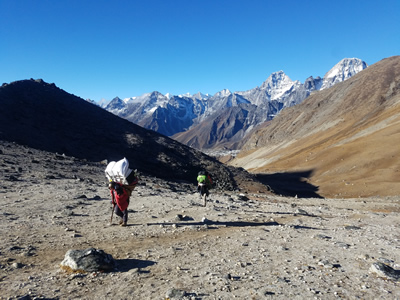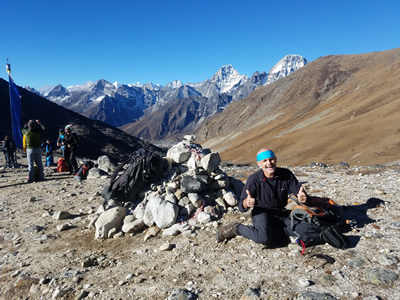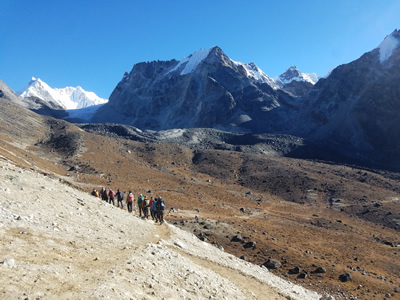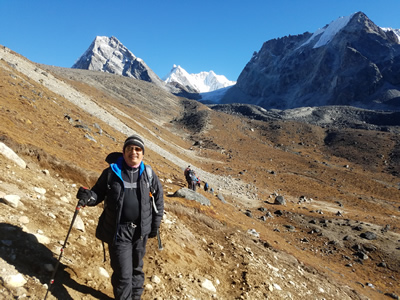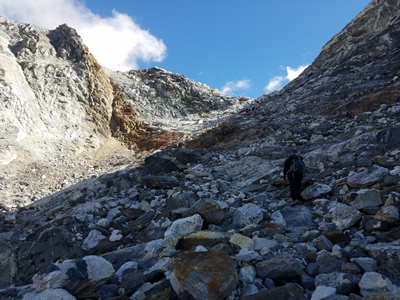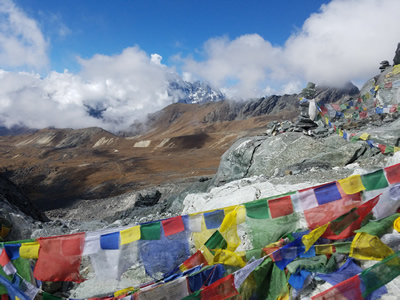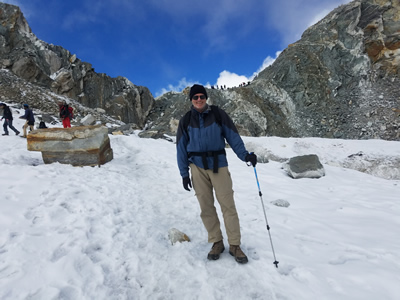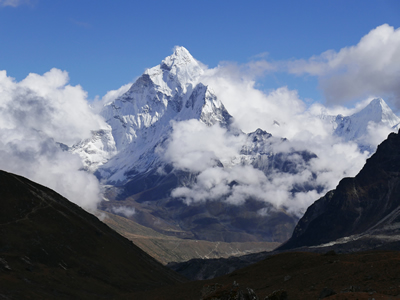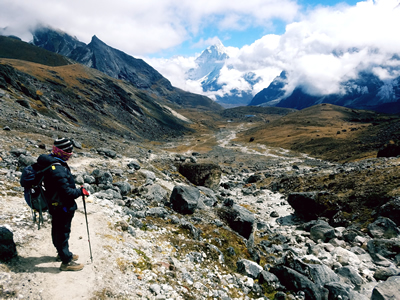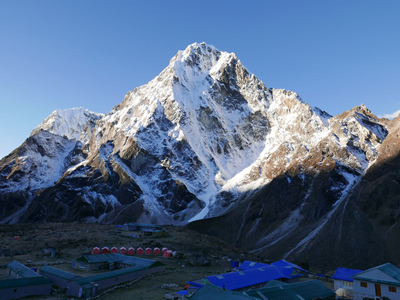Nepal Pt11: Crossing the Cho La
After climbing Gokyo Ri in the morning, we spent the afternoon hiking to the village of Dragnag. It was hard work to hike up a 17,585 mountain (hill actually) and then move to a new base afterwards, but it had been an outstanding day. The weather had been gorgeous, the scenery was spectacular and the altitude didn't bother me. At the end of the day I was feeling pretty good.
Unlike Gokyo, where there were at least half a dozen lodges, we didn't have much choice in Dragnag. It isn't really a village. It's just one and a half lodges. I say one and a half because there are two different buildings. One is more nicer but more expensive and caters to foreign trekkers while the other is cheaper and caters to Nepali porters and guides. I think the same people own and run both of them.
After we had trouble finding a place to stay in Gokyo, Shambu was nervous that we could have a problem in Dragnag. It's at one end of the route over the Cho La and is really the only option for a place to stay if you are going over the pass. When we started up Gokyo Ri in the morning, Shambu sent Awshuk ahead to reserve rooms for us. That turned out to be a good move because by the time we arrived there were already a lot of trekkers at the lodge. Fortunately Awshuk had been there early and was able to get spots for all of us.
My sleeping room was nice but there were only two squat toilets that were shared by everyone in the building. Because there were so many people using them they were pretty gross. In fact, they were the worst bathroom facilities I had to use on the whole trip. Since there were no other options for places to stay I didn't worry about it. As an old saying from my chess playing days goes - forced moves are easy.
In Dragnag we were at 15,420 feet. That's very high and it meant that it got cold at night. Rather than shiver alone in my sleeping room I spent the evening in the dining room. It was warm in there. The stove had a fire going and the room was completely filled with people. It was almost too warm. I spent the evening talking to a number of other hikers. Tom, the trekker from England who I met in Lumde, was there. He had done a lot of traveling so we traded stories about places that we had each visited.
I met an American who was living in Adelaide. I think he was the first person I met who was visiting Nepal from Australia who wasn't from Melbourne. It was nice to find out that there was more than one city there. He and his wife had moved to Australia because of their work and really liked it there. They had also been really impressed by the health care system there. Since they didn't like the way poliltics were going in the US, they decided to stay in Australia permanently and were in the process of applying for citizenship. Pretty extreme but I wonder if more people will start to emmigrate from the US.
Someone came up to me and asked me if I was from Boise. I was puzzled at first but then he pointed to the Boise State hat that I was wearing. His name was Donald and he was from Ireland but he had lived in Boise for eight months. He was a graduate student in natural resource management and had done an internship in Idaho. He worked for the BLM in the Owyhees and for the Forest Service in Boise National Forest. He shared an apartment in Hyde Park with some other students and got to know Boise well. He also knew the Sawtooths (my home mountains) so we talked about hiking and climbing there. When I travel I'm always amazed at the places I run into people who have connections to Idaho and Boise.
We had another oh-dark-thirty start the next morning. I skipped breakfast and just had some tea. By now Shambu was used to my strange (lack of) eating habits and didn't say anything.. At 5:20 we were ready to rock and roll. The sky was totally clear and there seemed to be a million stars out. That was good news but it meant that the temperature had dropped enough overnight that the air had a real bite to it.
This morning I went as light as I could. Although it was dark, I didn't take my headlamp. I didn't take my down jacket or as many other warm clothes as I had the day before. I was determined to do better getting to the pass and to do it while I was carrying my own pack. That meant there was more stuff for Awshuk to carry in my duffle bag but he's a lot younger and stronger than me.
Going light worked out well. It was dark when we left but it started to get light in less than half an hour. In the meantime Shambu had his light and so did others on the trail. I did fine without mine.
I was a little cold when we started out but it wasn't bad. Today I was trying something new. I had owned a neck gaiter for a long time, so long that I don't even remember when I got it, but I'd never used it. Shambu had one and used his all the time. Sometimes he used it as a neck covering but if he was really cold he would pull it up and use it as a facemask. Based on his recommendation I gave it a try and it worked great. For such a small and light piece of gear it really helped keep me warm. After we had been moving for a while I warmed up. I was glad I hadn't brought along a lot of extra clothes.
We started by climbing up a narrow side valley. Soon the sunlight hit the tops of the big mountains behind Dragnag, across the main valley. The sight was spectacular. It was another beautiful day in the mountains and it was great to be hiking. I felt strong and we made slow but steady progress.
Bistari, bistari.
It took us about two hours to climb out of the valley. We came out into the sunlight and then a little later topped out on the big slope that we had been climbing all morning. We were on a low ridge on one side of an upper valley. Across the valley was a line of big rock peaks. There was an obvious low point that was the Cho La. We had to drop into the valley and cross piles of glacial debris to reach the last slope up to the pass. It didn't look far but on the Renjo La I had learned that the landscape here was a lot bigger than it looks at first. The Cho La was still a long way off.
But we had just climbed a big hill so we stopped and took a break. There were a lot of other trekkers and they all had the same idea so pretty soon there were a lot of hikers resting on the ridgecrest. It was warm in the sun so everyone was shedding layers of warm clothes. Tom, my new friend who I had gotten to know pretty well the past few days, was already there. We traded taking photos of each other and swapped email addresses so we could send the pictures to each other when we got back home.
It was discouraging to give up any of our hard won elevation gain but when we started again the first thing we had to do was drop down into the valley. It turned out that I was right. The valley was big and it took a long time to cross it. Going up and down through the loose glacier debris was tiring and tedious. I just went slowly.
Bistari, bistari.
Eventually we came to the last steep slope up to the pass. It was hard work but I felt great. Four days over fourteen thousand feet and I had acclimatized well.
We reached the Cho La. At 17,782 feet it was the highest point we reached on the trip, about two hundred feet higher than the Renjo La and Gokyo Ri. It took us about five hours but all the loose rock had slowed us down. I felt a lot of satisfaction at meeting the physical challenge. Hey, I'm sixty four years old. I thought that I had done well for an old guy.
The pass itself was not much of a destination. Unlike our two other high points the past few days, there wasn't a great view. The scenery had been much better from our earlier stopping point on the crest of the ridge. It was crowded at the pass. There were a lot of people here, maybe thirty or so. There was one large group from Spain that was posing for a lot of group pictures. There was a lot of trash laying around. I don't understand how people can come and hike in these amazing mountains and then wreck it by leaving trash behind. Bottom line, the pass wasn't a nice place to spend time.
Clouds had moved in over the course of the morning and it was windy at the pass. Shambu and I were getting cold so we didn't want to stay long. After dropping down a short distance on steep rock there was a large glacier/snowfield to cross. There was a small bergschrund at the top and the Spanish group, which had left just before us, was trying to cross. The shrund wasn't very big but even at the easiest point they were struggling. We got tired of waiting in line behind them and just went around them. Even without ice axes it was really easy. I don't know why they were having so much trouble.
We descended a long way on the snow. It was steep in spots and my trekking pole came in handy. When the snow got too steep we moved onto a rock ridge. In places we had to do some scrambling. In other places we had to descend steep, loose dirt and rocks. It was very tiring and we had to be very careful not to slip. This side of the Cho La was definitely the toughest slope that we had to tackle on the trip.
Eventually we reached the floor of the valley. We still had a long way to go but now it was just walking on a trail, and downhill at that. We were hiking straight at Ama Dablam, thought by some people to be the most beautiful mountain in the world. This wasn't the standard view, we would see that the next day from Tengboche, but it was still an unbelievable pyramid of snow and rock. While clouds swirled over all of the other mountains, only Ama Dablam was in the clear. It was a memorable sight. Even though I was tired I was still loving this hike.
After a long descent we finally reached the village of Dzongla, which was our destination for the night. Like Dangnag the night before, it's only there because it provides an overnight stopping point for trekkers who are going over the Cho La. At least there were three teahouses so we had some options. Awshuk had arrived ahead of us and already secured places for us to stay at one of the teahouses, the Maison Sherpa.
Although high, cold and stark the setting was spectacular. Clouds swirled around the mountains but we could still see Ama Dablam down the valley. Just above us loomed the massive face of Cholatse but we could only see hints of it through the clouds. At dawn the next day, when the skies had cleared, it would be perhaps the most magnificent sight of the entire trip.
It had been another wonderful day of trekking in these incredible mountains. I was especially pleased that I felt strong again while I was hiking. I had been discouraged a few days before when I had to struggle so hard to make it over the Renjo La. The last two days I felt more like myself and hiking had been fun again. It was good to be in the Himalayas.
